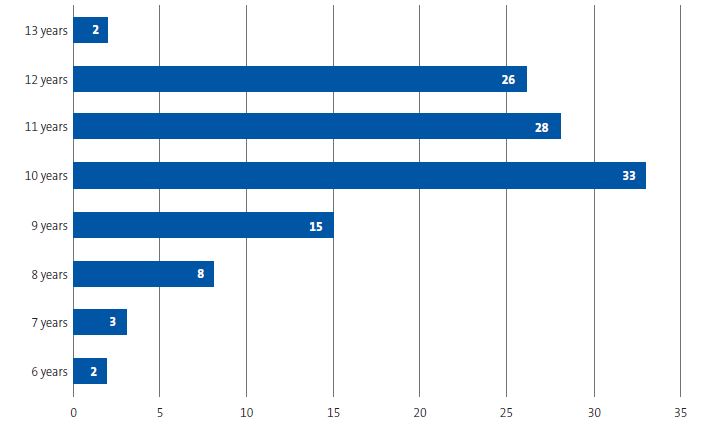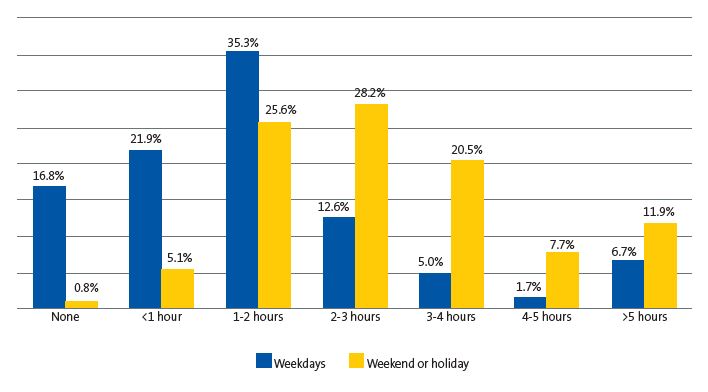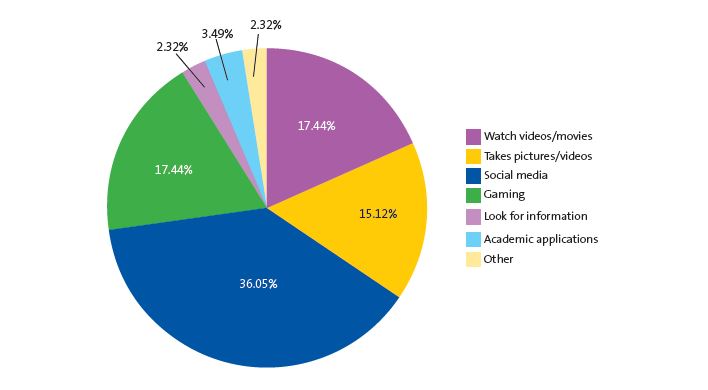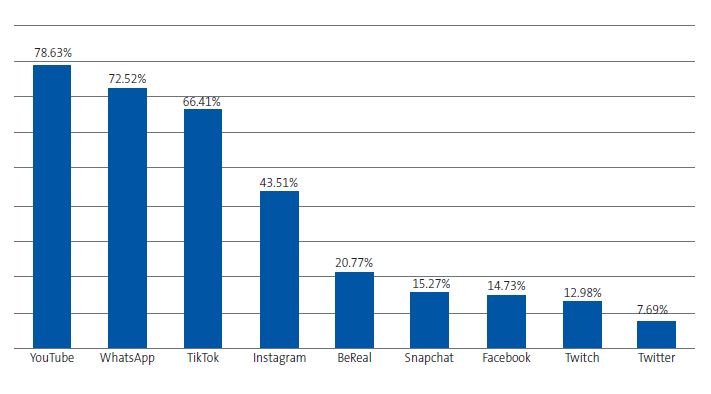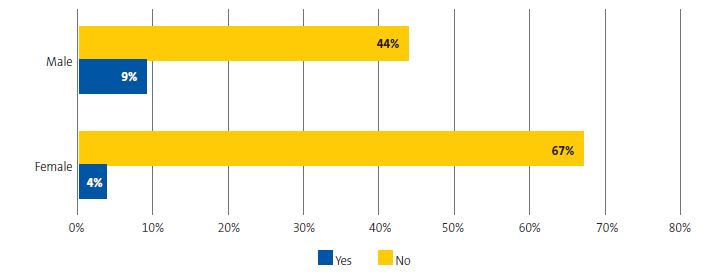Vol. 27 - Num. 105
Original Papers
Use of social networks and mobile devices in the child population of La Rioja
María de Pablo de las Herasa, M.ª Luisa Padilla Estebanb, Sara Pasamón Garcíaa, Cristina García Muroa, Cristina Toledo Gotorc, Nisa Boukichou Abdelkaderd
aServicio de Pediatría. Hospital Universitario San Pedro. Logroño. La Rioja. España
bPediatra. CS Orcasur. Madrid. España.
cPediatra. CS. Arnedo. La Rioja. España
dEstadística. Unidad de Ciencia del Dato. Innovación Sanitaria de Fundación Rioja Salud. Centro de Investigación Biomédica de La Rioja (CIBIR). Logroño. La Rioja. España.
Correspondence: M de Pablo . E-mail: mdepablo@riojasalud.es
Reference of this article: de Pablo de las Heras M, Padilla Esteban ML, Pasamón García S, García Muro C, Toledo Gotor C, Boukichou Abdelkader N. Use of social networks and mobile devices in the child population of La Rioja . Rev Pediatr Aten Primaria. 2025;27:27-35. https://doi.org/10.60147/0573589c
Published in Internet: 29-01-2025 - Visits: 10551
Abstract
Introduction: children in the current generation grow up immersed in digital media. The use of digital technology can bring benefits to our personal lives, but when it starts at a very young age, it can lead to its abuse and exposure to potential risks. The main objective of the study was to describe the trends in the use of information and communication technologies by the pediatric population. Material and methods: observational, cross-sectional, analytical and descriptive study in a sample of 220 patients aged 7 to 13 years who visited the pediatric emergency department of the hospital for unrelated reasons. Results: of all survey respondents, 53.6% had a mobile phone of their own, with an average age at the time of acquisition of the first mobile phone of 10.16 years. We found no significant differences in the degree of supervision based on the nationality of the family or paternal educational attainment, although in the case of maternal attainment, we found was a greater degree of supervision in mothers with university studies. In addition, 66.3% of the sample used social media. Conclusions: the findings of our study offer a description of the use of mobile devices and social networks in children aged 7 to 13 years. We found widespread adoption of these devices, highlighting the use of social networks and a notable degree of parental supervision. Pediatricians play a fundamental role in promoting the healthy use of emerging technologies and in detecting the risks they entail.
Keywords
● Adolescent ● Internet ● Smartphone ● Social mediaINTRODUCTION
The current generation of adolescents is immersed in a digital environment. Traditional media, such as television and radio, have been complemented by emerging digital technologies that allow instant access to entertainment, information and knowledge, as well as social contact and advertising.1
According to a report carried out by UNICEF in 2023 on users aged 11 to 18 years, the mean age at which children received their first cell phone in Spain was 10.96 years.2 In Spain, the minimum age required by law to have an account in a social media platform is 14 years, and up to 89% of adolescents have at least one social media account.3
Lack of knowledge about the dangers involved and the preventive measures that can be taken to avoid them can put a large number of adolescents at serious risk. The use of social media is associated with lower life satisfaction, internalization of negative experiences, depression, anxiety, attention problems, insomnia and an increased risk of obesity.4,5 Cyberbullying is one of the most important risks associated with the Internet. It is usually an extension of traditional, face-to-face abuse. In a survey conducted among children and adolescents aged 11 to 18 years, 19.8% reported having experienced school bullying and 12.2% cyberbullying.6 Another of the risks associated with the use of the Internet is sexting, which involves sharing images of a sexual nature via cell phones or the Internet. Seven percent of Spanish people aged 11 to 16 years reported having received messages of a sexual nature, with important differences based on sex: nearly 10% of male participants reported having ever received this type of message compared to 5% of female participants.3 Addiction is yet another risk of using the Internet or social media. Some authors have suggested that approximately 10-15% develop addictive behaviors similar to those found in substance dependence, giving rise to manifestations of withdrawal and tolerance.7
Concerned by the impact of the excessive use of these technologies on the wellbeing of children and adolescents and with the aim of guiding families in their responsible use, the Asociación Española de Pediatría (AEP, Spanish Association of Pediatrics), through its Health Promotion Committee, has developed the Digital Family Plan, which provides evidence-based recommendations for the use of technology in the home.8 One of the current measures for the protection of children and adolescents in the use of social media is the establishment, in June 2024, of a draft bill aimed at guaranteeing their rights in the digital environment, including the protection of their personal data and restricting access to age-appropriate content.9
The primary objective of the study was to describe the use of information and communication technologies (ICTs) in the pediatric population of La Rioja. The secondary objectives were to describe the negative and positive aspects of social media, to determine whether the family supervised the use of these devices and to analyze whether there were differences in the use of mobile technology according to the nationality of the family, parental educational attainment and the sex of the child or adolescent.
MATERIAL AND METHODS
We conducted a single-center, prospective, cross-sectional, observational, descriptive and analytical study. The data were collected during the patient's visit to the pediatric emergency department of the Hospital Universitario San Pedro de Logroño, in the presence of the accompanying adults, between January 2024 and May 2024. We obtained approval from the Ethics Committee for Drug Research of La Rioja (CeimLar) prior to data collection.
Inclusion criteria
Patients aged 7 to 13 years who visited the pediatric emergency department for reasons unrelated to mobile device or social media use.
Exclusion criteria
- Patients with any limitation that would prevent them from completing the questionnaire autonomously.
- Patients whose parents or legal guardians refused to participate in the study.
- Patients classified as triage level I in the emergency department, requiring urgent care.
- Patients who completed the questionnaire during a previous visit to the emergency department.
The questionnaires were completed by participants, and their parents or legal guardians provided informed consent to their participation in the study.
The statistical analysis of the collected data was performed with the R Commander software. In the descriptive analysis, we expressed numerical variables as mean, median and standard deviations and qualitative variables as percentages. In the inferential analysis, we used the Student t test for paired and independent samples for quantitative variables and defined statistical significance as p < 0.05.
RESULTS
The sample consisted of a total of 220 children and adolescents, of whom one was eliminated from the analysis due to an error in the completion of the questionnaire (0.04% of the total). Of all participants, 53.6% had a mobile phone of their own, with a mean age at acquisition of the first mobile phone of 10.16 years (SD 1.80) and a minimum age of 6 years (SD 1.80) (Figure 1). On the other hand, 46.4% did not have their own phone, but within this group, 69.6% used their parents’ devices on a daily basis.
When we considered the nationality of the family (Spanish, 73.6% vs not Spanish, 26,4%), we found that the mean age at acquisition of the first mobile phone was 10.30 years in children of Spanish origin compared to 9.94 in children from families of other countries, a difference that was not statistically significant (p = 0.311).
Regarding the daily use of electronic devices, televisions were used most frequently (73.2%), followed by mobile phones (65%) and tablets (40%).
When it came to the time spent using mobile phones, we found a daily usage greater than 5 hours on weekdays in 6.7% of respondents and on weekends or holidays in 11.9% of respondents (Figure 2).
The main purpose for which respondents used mobile devices was social media (36%), followed by gaming (17.4%) and watching videos or movies (17.4%) (Figure 3).
In terms of withholding the device, 58.3% of respondents reported that their parents kept their mobile phones during school hours, so they had no access to them, and 28.7% that parents withheld mobile phones during weekends and holidays.
Regarding supervision by adults/guardians, 87.9% reported that their use of mobile devices was monitored, most commonly through monitoring applications (59.4%), followed by direct supervision (52.8%), set schedules (40.5%) and signed contracts (4.7%).
We also analyzed whether there were differences in supervision in relation to family origin. In our study, the percentage of supervision was somewhat higher in families of non-Spanish origin (89.2% vs. 88.3%), but the differences were not significant (p = 0.872). Thus, we did not find a significant association between the nationality of the family the degree of supervision. We also explored differences in the degree of supervision according to maternal and paternal educational attainment, establishing 3 categories: primary education, vocational education and university education. In relation to maternal education, we found the highest degree of supervision in those with university studies (34.8%), followed by mothers with vocational training (33.1%) and the lowest degree in those with primary education (26.1%), differences that were statistically significant (p = 0.047).
With respect to the use of social media, 66.3% of the participants used social media, and, in this subset, as many as 67.1% used four or more social media platforms. The most popular platforms were YouTube (78.6%), WhatsApp (72.5%) and TikTok (66.4%) (Figure 4).
In terms of social network privacy, 15% of respondents reported having public Instagram profiles, 83.3% had private profiles and 1.7% were unsure. As to their contacts in social networks, 78.7% reported that their contacts corresponded to real-life friends, while 21.3% had contacts they had become acquainted with through these platforms.
We identified several negative aspects related to the use of social media: 18.3% of respondents reported being the target of insults through social media; 40.5% had received messages from strangers from time to time and 1.6% frequently; 12.2% had received photographs from strangers and 18.5% had received follow requests from strangers. Similarly, 8% had received images with sexual content and 10.5% with violent content. With respect to social media safety, 35.2% of the participants did not know how to change the privacy settings of their profile and 10.5% did not know how to block messages.
When it came to differences based on sex, we found no significant differences in being subject to insults through social media (p = 0.480) or in receiving messages or photographs from strangers (p = 0.284 and p = 0.784, respectively). We found a significant difference in the use of these devices to play video games, with 50% of male participants reported daily use for gaming compared to 23.1% of female participants (p = 0.0001). With respect to receiving images of a sexual nature, the percentage was higher in male participants (11.3% vs. 5.3% of female participants), although the difference was not significant (p = 0.323). However, we found significant differences in the exposure to images with violent content, which 16.9% of male participants reported receiving, compared to 5.6% of female participants (p = 0.031) (Figure 5).
Tables 1 and 2 summarize the results of the descriptive and inferential analyses.
| Table 1. Descriptive analysis of the sample | |
|---|---|
| Sample (n) | 220 children 44.55% ♂ 55.45% ♀ |
| Had own mobile phone | 53.6% |
| Mean age of ownership of first phone | 10.16 (SD 1.80) |
| Most used electronic device | Television 73.2% |
| Usage >5 hours/day | Weekdays 6.7% Weekend/holidays 11.9% |
| Parental withholding of mobile phone | Weekdays 58.3% Weekend/holidays 28.7% |
| Main use of mobile phones | Social media 36.1% |
| Parental supervision | 87.9% |
| Primary monitoring method | Parental control apps (59.4%) |
| Had social media account(s) | 66.33% |
| Most used social media platform | YouTube (78.6%) |
| Mean time spent in most used app | 68.53 (SD 51.24) |
| Main purpose of social media use | Entertainment/Fun 49.0% |
| Type of contacts in social media platforms | 78.7% real-life friends |
| Subjected to insults through social media | 18.2% |
| Had received messages from strangers | 42.1% |
| Had received photographs from strangers | 12.2% |
| Had received images of sexual nature | 8.0% |
| Exposed to violent content | 10.46% |

| Table 2. Inferential analysis of the sample | |
|---|---|
| Difference in mean age at getting first mobile phone: Spanish family vs. other nationality | No significant differences (p = 0.311) |
| Difference in supervision: Spanish family vs. other nationality | No significant differences (p = 0.872) |
| Difference in supervision based on maternal educational attainment | Greater supervision in mothers with university degrees (p = 0.047) |
| Difference in supervision based on paternal educational attainment | No significant differences (p = 0.341) |
| Difference in receiving insults: male vs. female participants | No significant differences (p = 0.480) |
| Difference in exposure to sexual content: male vs. female participants. | Male 11.3% vs. female 5.3% Not significant (p = 0.323) |
| Difference in exposure to violent content: male vs. female participants | Male 16.9% vs. female 5.6% (p = 0.031) |

DISCUSSION
The primary objective of the study was to describe the use of mobile devices and social media in children and adolescents aged 7 to 13 years. Compared to data at the national level, the mean age at which children in the sample acquired their first mobile phone was a bit younger, 10.16 years compared to 10.96 years.2 In this survey, 53.6% of respondents had a mobile phone of their own. We did not find comparative studies in the same age group, but according to data from the Instituto Nacional de Estadística (National Institute of Statistics of Spain),10 in 2023, 82.5% of children aged 10 in 15 years in La Rioja had a mobile phone, and this autonomous community had the highest proportion of mobile phone ownership in this age group in Spain along with Extremadura (85.9%).
One of the most encouraging findings was the level of family supervision, at 87.9%, compared to 29.1% nationwide.2 It is worth mentioning that when it comes to parental control applications, authorization from the minor is required for their parents or guardians to access their accounts, since, in Spain, the law establishes that those over the age of 14 must personally consent to it.11 With regard to differences in supervision, we only found a significantly greater degree of supervision in mothers with university studies compared to mothers with lower educational attainment. We did not analyze differences in the degree of supervision based on parental sex. Other studies have found that a higher level of education and professional status is associated with a greater probability of parents engaging in various forms of online mediation and monitoring12 and more frequent or greater supervision by mothers compared to fathers,13 which highlights the responsibility assumed by women in the digital education of their children. We ought to highlight the lower percentage of children that had social media accounts in the surveyed sample, of 66.3% compared to 89% nationwide. We did not find any previous studies analyzing differences in the degree of supervision or use of mobile phones based on the national origin of the family.
We ought to highlight the lower percentage of children that had social media accounts in the surveyed sample, of 66.3% compared to 89% nationwide,2 probably due to the younger age of the children in our sample compared to other studies.
As for the risks derived from the use of emerging technologies, our findings were similar to those of other studies carried out in Spain.
With regard to differences in the use of technology based on sex, we found differences in daily use of the devices for gaming and the exposure to violent content, which were more common in male respondents. We found no significant differences in the rest of the variables under study, probably due to the small sample size. Studies that analyze differences based on sex have found a higher frequency of gaming, sports betting and consumption of adult content in men.14
Among the identified limitations of the study, we ought to highlight that the completion of the questionnaire in the presence of the parents may have influenced the responses provided by the patients. The small sample size may have compromised statistical power for some of the variables under study. Another limitation was the variation in the interpretation of the concept of the family’s nationality on completing the questionnaire, as the aim for the purpose of the study was to analyze cultural differences in the use of technology. Children and adolescents born in Spain, even if their parents were not Spanish nationals, were included in the Spanish nationality group, which may have interfered with the analysis of cultural differences.
CONCLUSION
We found evidence of widespread use of these devices, in which we ought to highlight the use of social media and a high level of parental supervision. However, we also identified associated risks, such as cyberbullying and exposure to inappropriate content. These findings underscore the need to provide education on cybersecurity and implement effective strategies to promote a decrease in the use of social media and safer and healthier use of technology among youth, as well as the importance of supervision adapted to the specific family and school context.
As pediatricians, we are committed to protecting the health of children and adolescents and we must play an active role in guiding the appropriate use of new technologies. From the pediatrician's office, we can promote rational and responsible use, detect the potential consequences and risks of using mobile phones and social media, and encourage avoiding the use of mobile devices in children aged less than 6 years, as recommended in the digital plan of the AEP.
Regarding future research, it would be relevant to delve deeper into the mechanisms of digital education and into the education of families on the risks and benefits of technology in order to establish strategies to guide the safe and responsible use of digital platforms. We would also suggest performance of longitudinal studies to observe the impact of these trends on the social and emotional development of children and youth in an increasingly digital world, as we all need to be aware of the dangers that it poses.
CONFLICTS OF INTEREST
The authors have no conflicts of interest to declare in relation to the preparation and publication of this article.
AUTHORSHIP
Author contributions: main contributor to manuscript draft, data collection, literature search, statistical analysis (MPH), main contributor to manuscript revision (MLPE), data collection, literature search (SPG), data collection (CGM and CTG), statistical analysis (NBA).
ABBREVIATIONS
AEP: Asociación Española de Pediatría · ICTs: information and communication technologies.
REFERENCES
- Reid Chassiakos YL, Radesky J, Christakis D, Moreno MA, Cross C. Children and Adolescents and Digital Media. Pediatrics. 2016;138(5):2016-2593. https://doi.org/10.1542/peds.2016-2593
- Impacto de la tecnología en la adolescencia. Relaciones, riesgos y oportunidades. Un estudio comprensivo e inclusivo hacia el uso saludable de las TRIC. In: UNICEF España [online] [accessed 14/01/2025] Available at unicef.es/publicacion/impacto-de-la-tecnologia-en-la-adolescencia
- Garmendia M, Garitaonandia C, Martínez G, Casado MA. Riesgos y seguridad en internet: Los menores españoles en el contexto europeo. In: EU Kids Online [online] [accessed 14/01/2025] Available at https://xtec.gencat.cat/web/.content/alfresco/d/d/workspace/SpacesStore/0030/ebba70a0-aa59-4f10-abb5-c502404397bc/apdcatdefinitiu.pdf
- James C, Davis K, Charmaraman l, Konrath S, Slovak P, Weinstein E, et al. Digital life and youth well-being, social connectedness, empathy, and narcissism. Pediatrics. 2017;140(2):71-75. https://doi.org/10.1542/peds.2016-1758F
- Pérez M, Salmerón M. El entorno y la influencia en la adolescencia: familia, amigos, escuela, universidad y medios de comunicación. Pediatr Integral 2022;26(4):214-21.
- Salmerón M. Maltrato de la población adolescente a través de las TICS (grooming, sexting, ciberbullying). 2022;10:103-105.
- Moreno MA, Eickhoff J, Zhao Q, Suris JC. College Students and Problematic Internet Use: A Pilot Study Assessing Self-Appraisal and Independent Behavior Change. J Adolesc Health. 2019;64:131-3. https://doi.org/10.1016/j.jadohealth.2018.06.029
- Plan Digital Familiar. Recomendaciones generales para familias. In: AEP [online] [accessed 14/01/2025] Available at https://www.aeped.es/sites/default/files/plan_digital_familiar_inf.pdf
- Anteproyecto de Ley Orgánica para la protección de las personas menores de edad en los entornos digitales. In: Ministerio de la Presidencia. Gobierno de España [online] [accessed 14/01/2025] Available at https://acortar.link/Lreu66
- Uso, por los niños de 10 a 15 años, de ordenador e Internet y lugar de uso en los 3 últimos meses y disposición de teléfono móvil, por sexo, edad, hábitat, tamaño del hogar, tipo de hogar e ingresos mensuales netos del hogar 2023. In: INE [online] [accessed 14/01/2025]. Available at ine.es/jaxi/Datos.htm?tpx=50168#_tabs-tabla
- Ley Orgánica 1/1996, de 15 de enero, de Protección Jurídica del Menor, de modificación parcial del Código Civil y de la Ley de Enjuiciamiento Civil. In: BOE [online] [accessed 14/01/2025]. Available at boe.es/eli/es/lo/1996/01/15/1
- Dedkova l, Smahel D. Online Parental Mediation: Associations of Family Members’ Characteristics to Individual Engagement in Active Mediation and Monitoring. J Fam Issues. 2020;41(8):1112-1136. https://doi.org/10.1177/0192513X19888255
- Jiménez-Morales M, Montaña M, Medina-Bravo P. Childhood use of mobile devices: Influence of mothers’ socio-educational level. Comunicar. 2020;28(64):21-8. https://doi.org/10.3916/C64-2020-02
- Carbonell X, Chamarro A, Oberst U, Rodrigo B, Prades M. Problematic Use of the Internet and Smartphones in University Students: 2006-2017. Int J Environ Res Public Health. 2018;15(3):475-7. https://doi.org/10.3390/ijerph15030475





